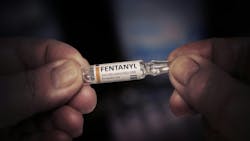Key Highlights
- The initiative seeks to harmonize DOT testing procedures with HHS guidelines, including updates on urine and oral fluid testing methods.
- Recent data shows a sharp increase in fentanyl detection in workplace drug tests, raising concerns about on-the-job use and safety risks.
- Fentanyl's high potency and its presence alongside other drugs like marijuana and amphetamines complicate efforts to ensure transportation safety.
- The regulation aims to improve detection, clarify training requirements, and address the growing public health threat posed by fentanyl overdose deaths.
Analysis
A rule proposed by the Department of Transportation (DOT) would add fentanyl and norfentanyl (a metabolite of fentanyl) to its drug testing panels for the operators of transportation equipment in interstate commerce who come under federal jurisdiction.
The proposed rulemaking would harmonize part 40 with the U.S. Department of Health and Human Services (HHS) Mandatory Guidelines for Federal Workplace Drug Testing Programs, which DOT is required to follow when adopting its minimum list of drugs for which it will require testing, the department said.
“Adding fentanyl and norfentanyl is also in the interest of transportation safety, given compelling information regarding the number of overdose deaths in the United States involving fentanyl,” DOT said when it published the rule.
A widely-reported epidemic of drug overdoses, many fatal because of the highly toxic nature of fentanyl, has captured the public imagination. Reportedly most of the fentanyl entering the U.S. comes in across the southern border smuggled by the same people bringing in illegal immigrants.
DOT has been gathering public comments and other input about adding fentanyl and making other possible changes in its drug testing regulations since 2023, before the fentanyl problem became a formal part of President Trump’s campaign platform.
In addition to the fentanyl addition, the DOT is proposing to change certain provisions of its drug testing regulations to ensure that they are in congruence with the current HHS mandatory testing guidelines regarding the use of urine (UrMG) and oral fluid (OFMG) testing procedures. The DOT proposal also seeks to clarify certain other DOT drug testing program provisions, including those applying to tester training, and will make other technical and language changes to the rule.
These technical changes apply to some of the procedures used and the gathering of additional evidence surrounding urine and oral testing—which was added to DOT testing requirements relatively recently—along with additional clarification of the training requirements’ language required under the rules for testing personnel.
The annual Quest Diagnostics Drug Testing Index, released in September, analyzed more than 8 million workplace drug tests. Quest found that although overall workplace urine drug positivity declined slightly in 2024—to 4.4% from 4.6%—there was a sharp increase in fentanyl in random drug checks, which suggests that more workers are using the highly addictive opioid after they have passed pre-employment screens.
Quest also pointed out that a report that had been released at the beginning of this year by the federal government’s Centers for Disease Control (CDC) showed a slight increase in fatal overdoses in January 2025 compared to January 2024, in the wake of several consecutive years of declines in those numbers.
“It is disturbing to see increased use of fentanyl on-the-job and in combination with other drugs, given fentanyl’s extreme potency, which can increase risk of impairment, accidents and potential overdose,” said Suhash Harwani, senior director of science for workforce health solutions at Quest. “It also raises concern that employees are turning to a dangerous drug like fentanyl after they’ve passed a pre-employment drug screen, putting the overall wellness of the workforce at risk.”
Who Is to Blame?
Earlier this year, the HHS Federal Drug-Free Workplace Program formally added fentanyl to its authorized drug testing panel for federal workers. Calling it “an urgent crisis,” HHS Secretary Robert F. Kennedy Jr. said, “Although overdose deaths are starting to decline, opioid-involved overdoses remain the leading cause of drug-related fatalities.”
During last year’s presidential campaign, fentanyl became a hot button issue after it received special attention from Donald Trump and his campaign, particularly because it was tied to the immigration crisis. The Mexican drug cartels largely responsible for smuggling the flood of millions of illegal immigrants across the U.S. southern border also piggybacked drug smuggling onto those operations with great success at a time when U.S. border enforcement officials were overwhelmed by immigration.
Trump also accused the Chinese of supplying the chemicals used by the Mexican cartels to manufacture the fentanyl they were smuggling across the border. Most recently, Trump has ordered the U.S. Navy to interdict Venezuelan boats bringing the drug into this country, actions that included sinking the boats and killing the crews in some instances.
Mexican government officials for years have objected to Americans choosing to saddle them with blame for our drug problem, pointing out that the issue would not even exist if had not been for Americans’ seemingly insatiable appetite for mind-altering drugs. The Quest Diagnostics report on workforce drug use supports the conclusion that recent actions taken to remove sanctions against the use of certain drugs like marijuana and hallucinogenic mushrooms have fueled the growth in other kinds of drugs Americans choose to abuse.
About 60% of specimens that were positive for fentanyl use in the 2024 workforce testing also were found to be positive for other drugs. For example, about 22% of the fentanyl-positive workforce drug tests also were positive for marijuana, a rate that has doubled since 2020, when only 10% of fentanyl positives were also positive for marijuana.
In addition, a large percentage of fentanyl positives were also found to be positive for amphetamines—16% in 2024 compared to 11% in 2020.
This appetite for psychoactive drugs lies at the heart of the rise of fentanyl’s fatal reign. All too often it has been sold to unsuspecting victims as something other than what it is, including some prescription medications. The war on drugs waged years ago is widely accepted to have been a failure, but if banning them isn’t the answer, perhaps it is time to come up with other ways of discouraging their widespread use, if that is even a realistic possibility.
About the Author

David Sparkman
David Sparkman is founding editor of ACWI Advance, the newsletter of the American Chain of Warehouses Inc. He also heads David Sparkman Consulting, a Washington, D.C. area public relations and communications firm. Prior to these he was director of industry relations for the International Warehouse Logistics Association. Sparkman has also been a freelance writer, specializing in logistics and freight transportation. He has served as vice president of communications for the American Moving and Storage Association, director of communications for the National Private Truck Council, and for two decades with American Trucking Associations on its weekly newspaper, Transport Topics.
